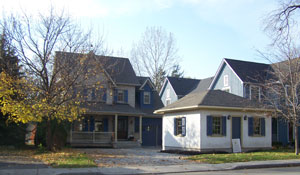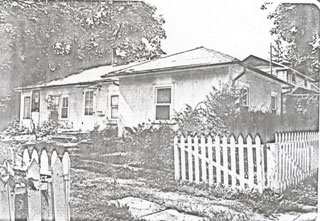| |
| Address: |
260 MAIN ST |
| Original Address: |
|
| Property Legal Description: |
CON 5 PT LOT 13 |
| Historical Name: |
Workers' Cottage |
| Heritage Conservation District: |
Unionville |
| Ward: |
3 |
| Year Built: |
c. 1845 |
| Architect Style: |
Ontario Cottage, Regency |
| Heritage Status of Property: |
Part V (Heritage) |
| Designation Bylaw: |
|
| Heritage Easement Agreement: |
Yes |
| |
|
|
|
|
History Description |
|
Ira White, a successful millwright from New York State, purchased the east 100 acres of Lot 13, Concession 5, in 1839. This property, at the north end of what later became the village of Unionville, contained a branch of the Rouge River. White dammed the river and created a large mill pond in the area now occupied by Toogood Pond. In 1839, he built a saw mill on a nearby property, and in 1840, a grist mill on his own lot. The grist mill was named the Union Mills in honour of the union of Upper and Lower Canada in 1841. When the emerging village established its first post office in 1849, the name Unionville was chosen, probably relating to the name of the mill.
The establishment of a milling operation provided an impetus for the formation of a village composed of mill workers, coopers, blacksmiths and other trades and businesses. Beginning in the mid 1840s, Ira White began selling off small parcels of his lot, fronting on the concession road now known as Main Street, Unionville. On these lots, most comprising a quarter of an acre, the modest frame homes of the mill workers and others were constructed. The cottage at 260 Main Street is one of these, and is the last intact example of its type remaining in north Unionville.
This cottage, built in a very simple, vernacular expression of the Ontario Regency Cottage style, is a one storey building with a low-pitched hip roof. The roof has a wide overhang, typical of the style. The 3 bay front, with a centre door, has been restored after being altered in the 1980s. The 6 over 6 sash style windows are also restored, replacing front bay windows and side 2 over 2 windows installed as alterations in the later history of the dwelling. The underlying construction of the exterior walls is of particular interest as an example of plank-on-plank or sawmill plank, a mid 19th century building technology that employed large amounts of inexpensive roughsawn lumber. The planks were laid in an offset pattern to allow interior and exterior plastering without the need for the application of lath.
|
|
|
| Contemporary Photograph |
Heritage Photograph |
 |
 |
| |
|
|
|
Key Map
Please note that the yellow polygon symbol is not indicative of the actual heritage area and is only meant to highlight the property the heritage building(s) is located at. For a complete description of the actual heritage property please refer to the Designation Bylaw found above. |
|
|
|